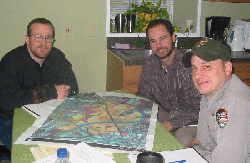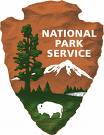Wainger
Lab
University of Maryland Center for Environmental Science
University of Maryland Center for Environmental Science
An Economic Decision Support Tool for National Capital Region (NCR) Parks
Non-native invasive plants threaten the mission of the National Park Service by reducing the ability of park lands to preserve local species diversity and serve visitor needs. Invasives are responsible for increased park maintenance costs, present risks to cultural and educational resources, and affect visitor safety.
Invasive species management presents challenges and opportunities to park managers as they strive to provide the highest level of ecosystem services from parks. This cooperative project between the National Park Service National Capital Region (NPS NCR) and the University of Maryland Center for Environmental Science is examining cost-effective strategies for managing non-native invasive plant species in parks.
We are working with the NPS Center for Urban Ecology to implement a risk-analysis framework within a spatial decision-support tool that will support park managers in choosing invasive species management that will most cost-effectively produce ecosystem service benefits.
The cost-effectiveness analysis has three main components:
1. Benefits or damages avoided from managing invasives
2. Costs of treatment
3. Probability of successful treatment
To estimate benefits of various management options, we characterize the threat that non-native species pose to the affected environmental and economic endpoints using a risk assessment framework (described below).
Costs of treatment are being developed from extensive park service records and a team of ecologists is evaluating the history of invasive treatment in NCR Parks to capture what is known about treatment effectiveness under different site and landscape conditions.
For a project summary, see a recent presentation given at the, "Spotlight On National Park Resources in the National Capital Region," Frederick, MD, April 20, 2010.
Risk Assessment Framework
| Our approach to assessing economic benefits of
invasive species treatment relies on characterizing and quantifying the
ecosystem services that people derive from natural systems. Ecosystem services are the beneficial outcomes that people receive from natural features and functions and they include a broad range of use and non-use values. Use values are those that generally require access or proximity to the site such as recreation, aesthetic/spiritual enjoyment. Non-use values are those that people hold for just knowing an ecosystem or its elements exist, often because people want to maintain the option to use the system or wish to preserve it for future generations. |

| Within
the risk assessment framework, invasive species are evaluated for the
changes they are likely to produce in site or landscape
features, such as a change in diversity of vegetation. These
site/landscape changes are
then evaluated for their potential to affect ecosystem functions
or processes such as providing nesting habitat for birds.
Functional changes are evaluated for their effects
on ecosystem services, such as birdwatching opportunities.
As a final step, changes in ecosystem services are evaluated in
terms of how they change human well-being. |
Literature review of impacts of invasive species.




